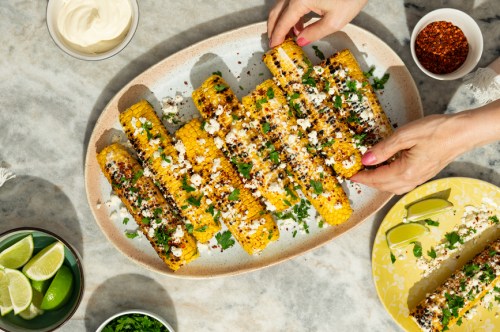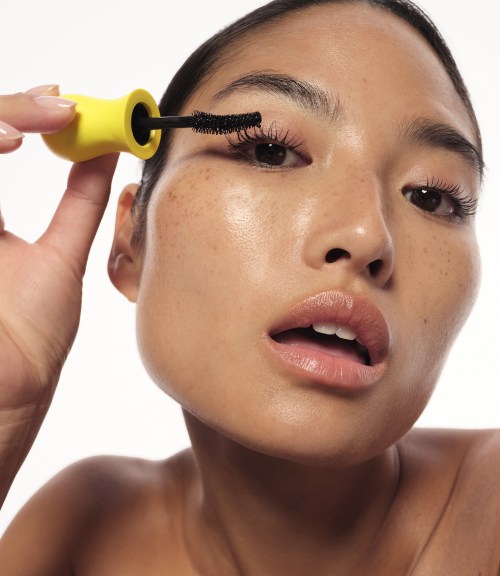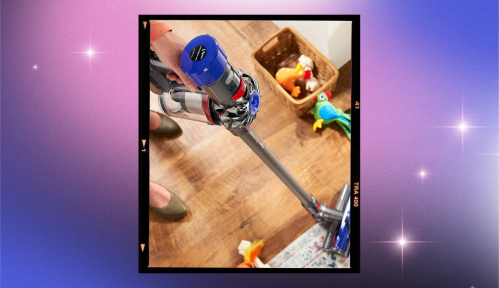Corn and human agriculture go way back; We’re talking over 10,000 years ago. It’s been an integral crop and one of the healthiest grains many civilizations have relied on for thousands of years.
Experts in This Article
registered dietitian and longevity nutritionist
registered dietitian and CEO and co-founder of Culina Health
But that should come as little surprise considering what’s there not to love about corn? At it’s simplest, it’s a mild-tasting ingredient with subtle hints of sweetness (depending on the variety) that can be prepared thousands of different ways. It’s also considered both a grain (when matured and dried used in foods like popcorn or tortillas) and a starchy vegetable (when consumed fresh, frozen, or on the cob). The best part? No matter how you choose to eat or cook with it, it’s nearly impossible to go wrong. From boiled corn on the cob to buttered movie theater-style popcorn to freshly prepared nixtamalized corn tortillas — as highlighted in Well+Good’s 2024 trends — corn lends itself to so many different preparations.
But how much do we really know about the humble ingredient, particularly regarding its bevy of health benefits? And why would the question of whether or not corn is good for you ever be contemplated? Ahead, we caught up with two registered dietitians to *dig* into the matter, and share more about the pros and cons of eating this staple food.
What are the pros and cons of eating corn?
Registered dietitian Kim Melton, RD, is here to set the record straight. She firmly believes corn absolutely has a place in a healthy diet, especially when it’s in season and readily available at the farmers’ market. So, is corn good for you? Right off the bat, Melton says undoubtedly yes. Of course, like most things in life, there are a few considerations to keep in mind and why you may want to limit your intake (more on that ahead).
3 benefits of eating corn
1. It’s lower in sugar than you may think
For starters, Melton acknowledges that some folks may believe corn is high in sugar — especially sweet corn — and therefore unhealthy, but she argues this simply isn’t the case. “Although corn is high in sugar, it doesn’t cause an unhealthy spike in blood sugar as some believe,” Melton explains. “This is because it’s actually a low-to-medium glycemic index food and can be a part of a healthy diet when consumed in moderation,” she says. For context, one medium ear of sweet white corn has 2.9 grams of sugar; meanwhile, sweet yellow corn has about six grams.
2. It packed with many essential nutrients
Besides not spiking blood sugar in most cases, Melton says corn is full of many essential nutrients, too. “In about half a cup of corn, you get four grams of protein [out of a recommended 50 to 75 grams a day], two grams of unsaturated fat, and 2.4 grams of fiber [out of the recommended 25 grams a day],” she says. The numbers may seem small, but they’re still a nice drop in the bucket—especially if you’re incorporating corn into other nutrient-dense meals like salads, Southwestern-style protein bowls, or quinoa.
“Corn also has manganese, phosphorus, magnesium, folate, potassium and some B vitamins,” Melton adds. Of these, it offers the most potassium, with a medium ear containing 275 milligrams (just about 10 percent of your recommended daily intake.) Because corn has potassium and carbs, it makes for a great—and totally underrated—post-workout recovery snack. On average, a medium ear of corn has 19 grams of carbohydrates, and these whole grain carbs play an important role in providing energy and even boosting happiness.
3. It can help reduce the risk of developing certain chronic diseases and improve digestive health
Research shows that corn contains tons of nutrients, vitamins, and phytochemicals that help lower the risk of developing chronic diseases such as cardiovascular disease1. Plus, corn is good for your gut and can help improve digestive health. The fiber in corn is great for digestion, adds dietitian Vanessa Rissetto, MS, RD. “That [corn] is high in fiber means it aids in gut health,” Rissetto says. “It’s considered a prebiotic, which is a compound in food that enhances the activity of good bacteria and helps probiotics do their job.”
4 potential disadvantages of eating corn
1. It can trigger allergic reactions for some folks
Corn is overall a great addition to your diet. However, that is unless you have an allergy to this golden veg. If that’s the case, Rissetto says to steer clear of corn. While it’s a relatively uncommon allergy, some groups might be sensitive to the vegetable and can experience symptoms like hives, itching, wheezing, or in severe cases, anaphylaxis when consumed. Corn is also susceptible to contamination by fungi that release toxins called mycotoxins, harmful, naturally-occurring chemicals created by fungus and mold. However, proper food safety regulation and sourcing should prevent this type of corn contamination in most cases. Keep in mind that mycotoxins are heat-resistant, meaning that cooking them won’t necessary destroy them.
2. It contains starches that may raise blood sugar levels for some individuals
Corn is considered a starchy vegetable that can potentially raise blood sugar levels. However, like most things in life, consuming it in moderation is key and the best way to mitigate this potential side effect.
3. It might hinder the ability to absorb other nutrients
Another potential disadvantage of eating corn is that it can contain an antinutrient called phytic acid (phytate). This can potentially hinder the body’s ability to absorb other essential nutrients, like iron and zinc, as well as it should. However, soaking the vegetable can help remove (and reduce) the levels of phytate present.
Is all corn good for you?
A common question that may crop up (pun intended) when speaking about corn is whether eating GMO (aka genetically modified organism) corn should be cause for concern. But in Melton’s opinion, the fear over GMOs is unfounded (in corn and otherwise). “There’s no need to avoid GMO corn,” she says. “The National Academy of Sciences has concluded that GMOs are safe to eat2 and the same conclusion has been reached many large scientific organizations. We have had GMOs in our food system for over 20 years and there has never been any negative health issues associated with them,” Melton says.
Indeed, a 2018 study in Europe looked at 20 years of research on GMO corn and concluded that it was likely safe because of the higher quality of grain produced and the reduction in human exposure to mycotoxins in certain foods. (Insects often carry fungus or facilitate fungal growth; because the GMO corn was insect-resistant, the study found it had less insect damage, which was associated with lower levels of mycotoxins.)
Of course, this is a somewhat controversial stance in the wellness world. Again, while lots of scientific research backs up the safety of GMO products, other experts may argue that it’s still too soon to know any potential long-term effects of GMO consumption. (Some believe that they could be the underlying cause of certain food sensitivities and gut issues, for example.) That said, if you would like to avoid GMOs, opt for certified-organic products when purchasing corn, and if you’re buying it at the farmers’ market, use this opportunity to talk to the farmers about their farming practices.
Bottom line: In case you’re still wondering, is corn healthy? It’s generally safe to say that despite some of the not-so-great rumors about the crop out there, like most vegetables, it’s can definitely play a role in a well-balanced diet.
What is the healthiest way to eat corn?
There are probably a million and one ways to eat corn. “Corn is part of the grass family and is a whole grain that can be eaten as polenta, popcorn, corn on the cob, or cornmeal,” Melton says. The most popular variety is sweet corn (it’s the yellow kind you’ll most likely find at the grocery store), but Melton says there are other varieties including red, orange, blue, and purple.
From popcorn to grilled to muffins, the healthy options for eating corn are endless. At Well+Good, some of our favorite (and healthiest) ways to eat it include these three-ingredient Venezuelan arepas packed with tons of protein and fiber or these seven healthy grilled corn recipes that go beyond just slathering a cob with a smothering of butter. Though, of course, there’s nothing wrong with the latter.
For a soul-soothing dish, this vegan coconut-ginger sweet corn soup is filled with anti-inflammatory benefits that will keep you warm and snuggly during a cold winter night. Or, if the heat is simply unbearable outside, this super-refreshing corn salsa recipe will do the trick. But if you truly want to reap the benefits of corn, nixtamalization, an ancient culinary technique that fully unlocks the nutritional benefits of corn, is the way to go. Corn cooked in this style can be used to make various dishes, such as tortillas, tlayudas, and tamales, to name a few.
Fortunately, whether you choose to eat corn canned, frozen, or fresh on the cob, it’s benefits are nearly all the same. However, keep in mind that canned or frozen corn may have slightly higher amounts of sodium. One of the best ways to mitigate these levels is simply giving it a good rinse.
How to make gluten-free corn arepas:
Sheng, Siyuan, et al. “Corn Phytochemicals and Their Health Benefits.” Food Science and Human Wellness, vol. 7, no. 3, 2018, https://doi.org/10.1016/j.fshw.2018.09.003.
↩︎Pellegrino, Elisa et al. “Impact of genetically engineered maize on agronomic, environmental and toxicological traits: a meta-analysis of 21 years of field data.” Scientific reports vol. 8,1 3113. 15 Feb. 2018, doi:10.1038/s41598-018-21284-2
↩︎
Sign Up for Our Daily Newsletter
Get all the latest in wellness, trends, food, fitness, beauty, and more delivered right to your inbox.
Got it, you've been added to our email list.











